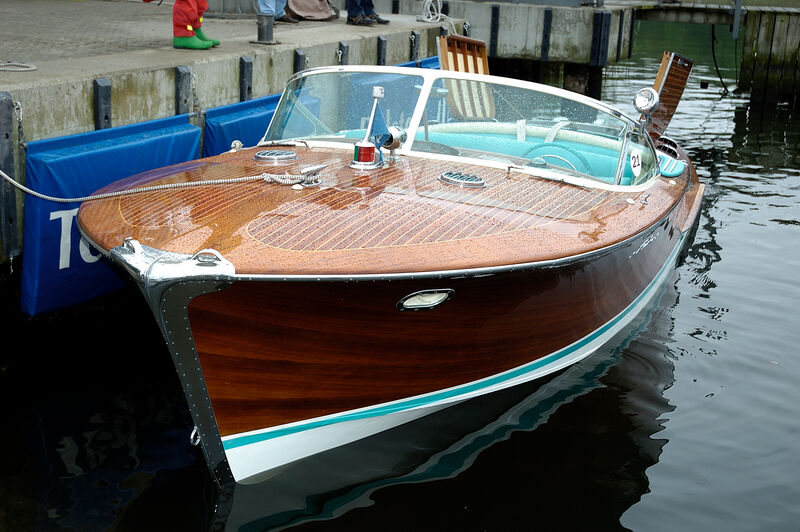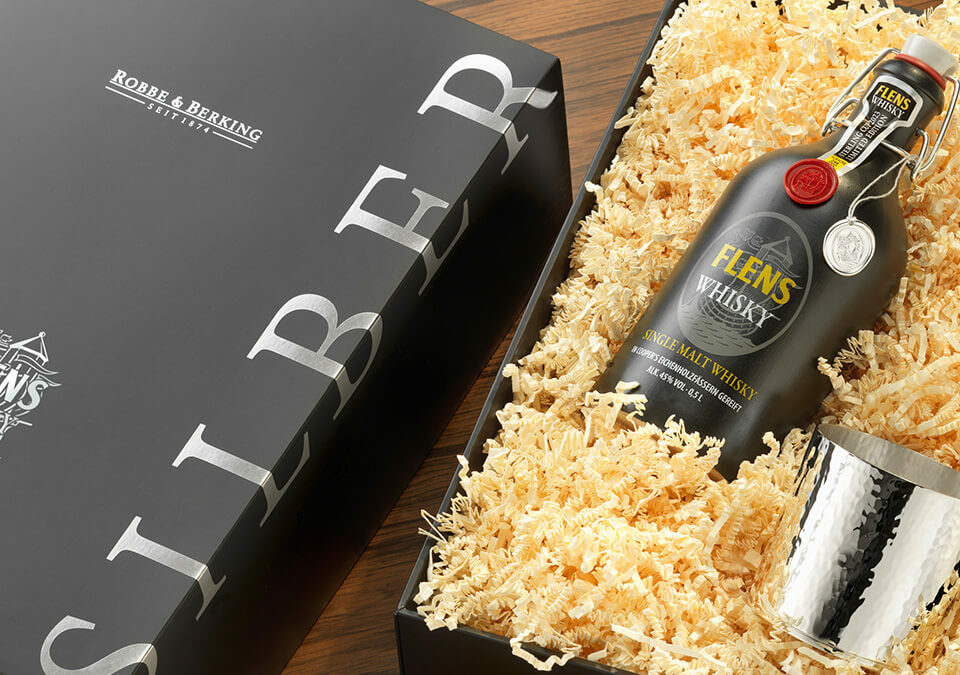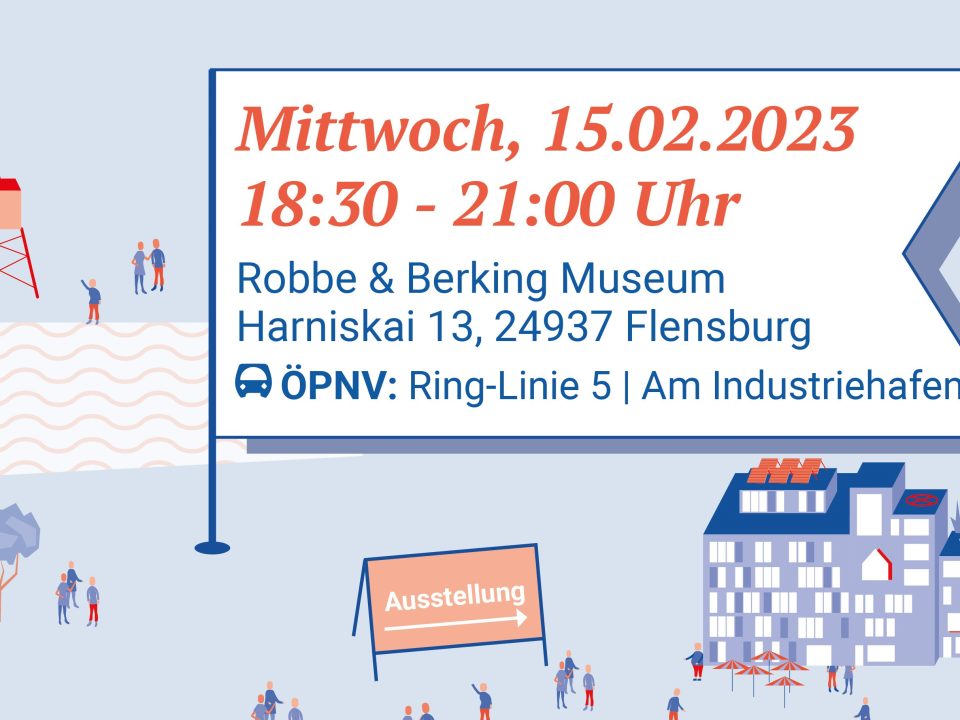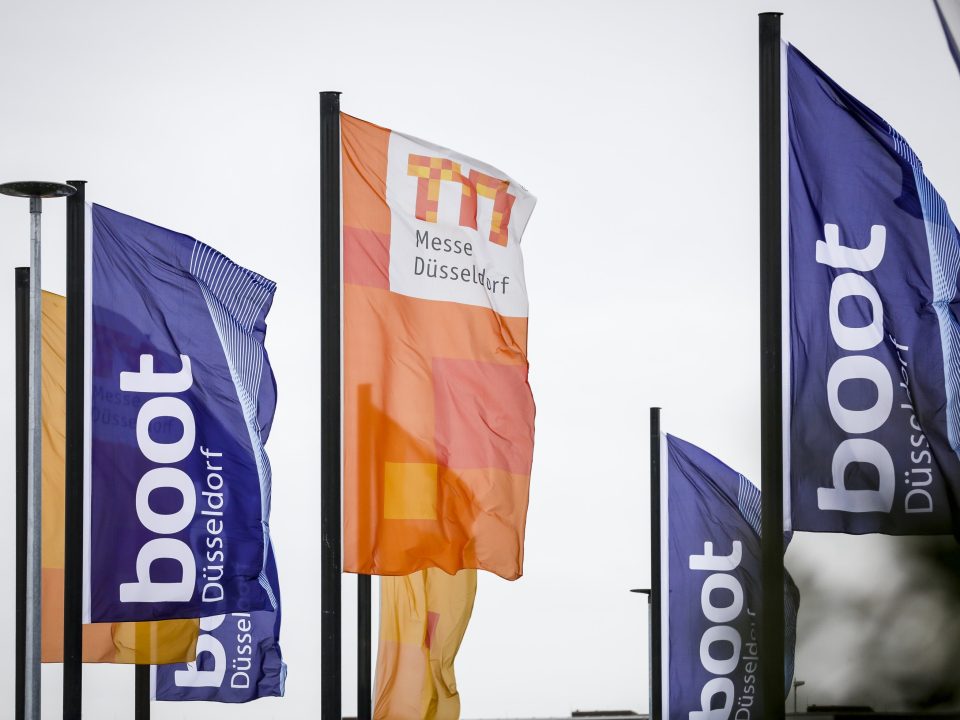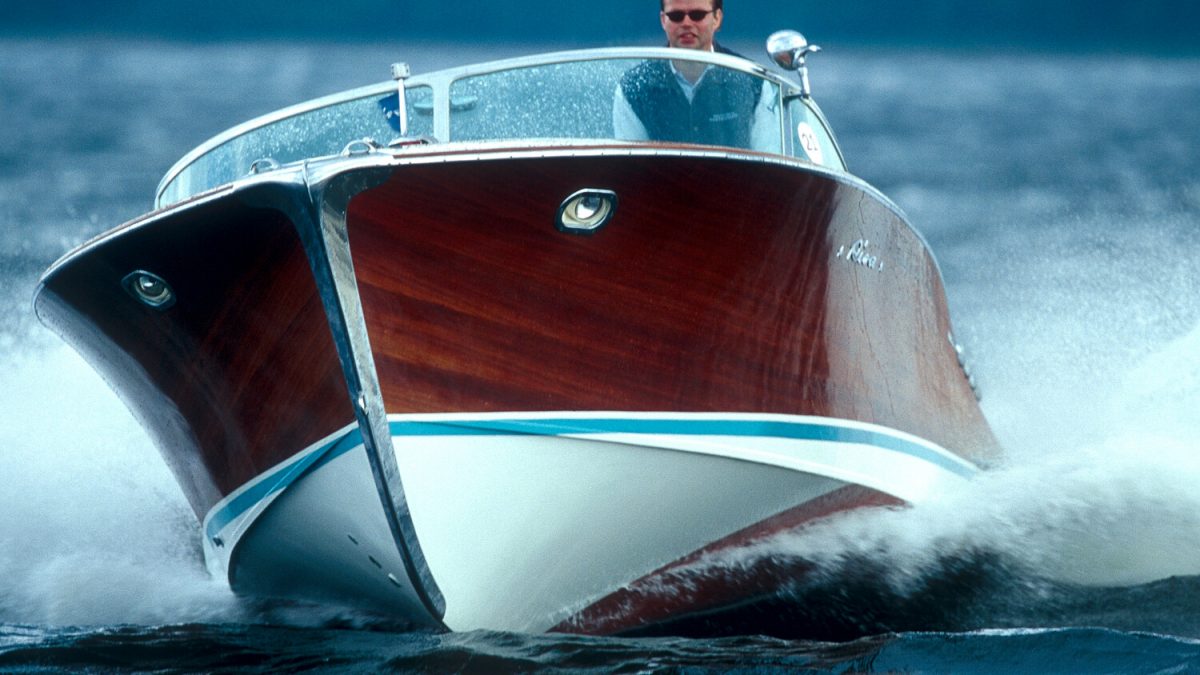
Within two decades Carlo Riva managed to turn a small family business into a world-famous brand.
Noble and stylish runabouts, fast open motorboats with elegant lines, built from shiny varnished mahogany and powered by loud engines. They already inspired the imagination and aroused desires in the 1920s and 1930s. These boats, which also found their way into the novels of F. Scott Fitzgerald, were, at that time, built mainly in America: by Chris Craft, Gar Wood or Hacker. After World War II however, a small Italian brand took over first place in the world of runabouts: Riva became synonymous with fast and elegant mahogany motorboats. It was Carlo Riva (1922 to 2017), great-grandson of the boatyard founder Pietro Riva, who made this remarkable story possible. It was a long journey from Pietro, who set out as a young man in his village in June 1842 to settle in Sarnico on Lake Iseo and start a boatbuilding business, to the world-famous brand which today is part of the Ferretti Group: 160 years later, in 2000, Norberto Ferretti bought 100 percent of the Riva shares. But the crucial part of the story takes place in the 1950s and 1960s – the rise of Riva, propelled by Carlo Riva. How did he manage that? In any case, the family always seemed to have had an entrepreneurial spirit. Carlo’s grandmother, the wife of Ernesto, son of Pietro, who ran the shipyard at the time, turned the boatyard canteen on the lakeside into a trattoria, as more and more day-trippers came to the lake. This way, Ernesto divided his entrepreneurial risks into two very different areas: boatbuilding and gastronomy. In contrast, his son Serafino, who had taken part in his first motorboat race in 1912, concentrated completely on one side of the business: to win races with the boats designed and built by his own boatyard. He was good at it and it was his way of marketing the Riva brand. In the 1920s, Serafino Riva designed and built racing boats with the engines under the long foredeck in front of the driver. These types of boats were also purchased as runabouts, for the sheer pleasure of it.
His son Carlo also wanted to win, but rather the hearts of the post-war generation of wealthy people who now frequented the Côte d’Azur and the Italian Riviera. Between Cannes and Portofino old money nobility mingled with the post-war nouveau riche, there was an unbridled zest for life and a longing for la dolce vita and the bel mondo. And Carlo Riva had a clear idea of how he could have his share of this, how his boatyard could benefit. Riva boats were known for their speed, but he felt the market for racing boats was too small. For the new generation of those who could and wanted to live a glamorous life, he had to offer nothing less than the perfect, accomplished boat. To achieve that, he saw only one solution. A series production of the highest quality. So far, the boatyard had been a pure handicraft business, each boat was a unique one-off. Carlo was ready to »enlarge the boatyard, modernize it, come up with something new and, if necessary, risk everything,« as he himself once said. Above all else he needed money. And he found energetic support in his friend Gino Gervasoni. Although he could not offer any money either, his youthful enthusiasm convinced some owners of Riva boats to invest in the modernization of the yard. With courage, optimism and energy, they survived the first years of the »re-start«. Inspired by the concurrent, breathtaking development of the automobile, especially in Italy, where the design studio »Pininfarina« created one future classic for Enzo Ferrari after the other. »I wanted to completely renew the architecture of the car,« Battista Pinin Farina said in an interview. This impressed Carlo Riva and inf luenced his boats and it is not a coincidence that their steering wheels and dashboards are so similar to those of a sports car. Because just like these, a Riva boat was not only a means of transport, but the expression of a new luxury. Riva was convinced that his boats had to make a similar impression on the water as a Ferrari did on the road. Completely detached from everyday life, with a distinctive, bold design, which has little in common with mere functionality.
And that each boat would have to be built in an obsessively perfect build quality. This was not easy, considering that wood is a living material that has to be processed individually. But Carlo set up his own type of production lines, with standardized malls and templates for cutting the individual parts. The wood was chosen with great care, mostly by him personally. Soon, for the bottom planking, the then completely new, lighter and stronger plywood was used. And despite this early serial production, it still remained highly skilled manual work. The varnishing of a new Riva took two months to complete: 16 layers of varnish, applied one after the other by hand in air-conditioned, dust-free chambers. While Carlo Riva was the perfectionist in the design and construction of his boats, his friend Gino Gervasoni took great care to put these wonderful creations on stage in the international scene with panache and flair. Soon there was a first agency in Rome, followed by a showroom in Santa Margherita Ligure on the Riviera, stands at the annual trade fair in Milan, and finally their greatest triumph: the Riva showroom at the Rockefeller Centre on Sixth Avenue in New York. And always and everywhere there was a meticulous attention to the perfect style. Even the trucks delivering the finished boats, with chrome hubcaps and twotone paintwork, had a sheen that was barely inferior to the boats they transported. Drivers, workers and deckhands always wore white overalls with the company logo, in blue, on the left breast pocket. It would not have looked out of place if they had all even worked wearing white gloves. At the very beginning of the range of new Riva models was the Corsaro, whose name was of course not chosen by accident. Like the elegant, fast corsair vessels from the past, this boat should surpass all others, and perhaps Carlo and Gino sometimes felt like the fearless and adventurous corsairs of those days. In any case, the boathwas the archetype of the »new Riva«. Compact lines, the cockpit in front just like a sports car on the water. And it could reach speeds of up to 70 km/h. The Corsaro was built until 1955. One of the first movie stars with a Riva was the Italian Alida Valli, who owned a house on Ischia and moored her boat there in the mid-1950s.
Then came the Tritone, named after Triton, son of Poseidon and Amphitrite. In line with this »godly origin« the boat itself proved to be divine, bringing the real breakthrough to Riva. She was the first model of the boatyard on the lake that was also truly seaworthy, ideally suited for the coasts of those areas where the potential customers of Riva liked to enjoy themselves. A good eight metres long, driven by two powerful engines, it was fast, stable and could accommodate up to ten people on board. In 1960 Anita Ekberg bought a Tritone and had the boat in Fiumicino during the filming of Fellini’s »La dolce vita«. Gunter Sachs had bought his Tritone back in 1957 and proved to be a good customer: in 1958 an Ariston was added, in 1962 he bought a Super Tritone and finally two Super Aquaramas, one in 1965 and one in 1969. These boats he had in Saint-Tropez and on Lake Geneva. Angelo Rizzoli, publisher and film producer (also of »La dolce vita«), first had an Ariston, then an Aquarama in the Mediterranean off Ischia; the island which he promoted significantly and turned into the meeting place of authors, actors and financiers. The actor Peter Sellers, famous as Inspector Clouseau in the movie »Pink Panther«, quenched his yearning for the sea with a Super Ariston (1966) and a Super Aquarama and a Riva Junior (1967). In 1963 Sophia Loren bought an Aquarama, the Aga Khan bought two of them, one in 1965 and one in 1970. This list could be continued for quite some time, also with Gilbert Becaud (Super Florida, 1963) and Jean-Paul Belmondo (Super Florida, 1964), as well as Elizabeth Taylor and Richard Burton, who had a Riva Junior as a tender on their yacht. And yes, of course there is Brigitte Bardot, who bought two Floridas, one in 1959 and one in 1962. The most legendary scene however, which is so beautiful that we do not want to again raise the question whether it is truth or myth, was supposed to have taken place on the Aquarama of Gunter Sachs. The two are said to have made love on the sundeck of the Aquarama – while the boat blasted across the Mediterranean in the direction of Africa with locked steering and at full throttle. »At that moment, we did not care if we would die«, Sachs is reported to have said. That’s not really surprising. At that time, many men would probably gladly have given their lives to experience such a love scene with BB…
At the debut of the Aquarama in 1962, Riva was already a famous name. Rivas were to found wherever life was celebrated, be it in Portofino, Cannes, Monaco, Saint-Tropez or Ibiza. The Aquarama was also the pinnacle of the Riva evolution, which had begun with the Sebino and the Florida. With its dimensions, the powerful engine and its shape, the Aquarama was a fitting descendant of the Tritone. »Such a magnificent, beautiful boat had never been seen before«, was said at the time, and perhaps this can still be said today. They were available in three models – Aquarama (8.02 metres, initially equipped with two Chris Craft 185 hp V8 engines, later with two Riva V8s of 220 hp each), Super Aquarama (8.45 metres, two engines of 320 hp) and Aquarama Special (8.75 metres, twice 350 hp). There was a small cabin for two under the foredeck and the large sundeck aft of the engines made famous by Brigitte Bardot and Gunter Sachs. The last wooden boat developed by Riva was the Olympic, introduced in 1969 as a replacement for the Florida. But by then, even at Riva, the age of plastic had begun. The Aquarama remained the pinnacle of wooden boats. Carlo probably felt that the Aquarama, even as Super Aquarama and Aquarama Special, would be very hard to surpass. It was the 1970s and Carlo, always open to new things, had his ideas again. The customers now wanted more comfort on board, instead of pure runabouts they also wanted cabins and bathrooms and much more, for a comfortable overnight stay on board. Carlo felt that plastic was the new material of choice. But times also changed in other ways. The first strike at his shipyard took Carlo completely by surprise, much more than the new materials or new boats did. Above all, the suddenly hostile attitude of his workers towards him was too much for him. In 1969, sitting in his beautiful office in the form of a ship’s command bridge overlooking the lake he decided to sell his shipyard to an American company: the end of a great era.
//
Text: Detlef Jens. This article appeared in GOOSE No. 29


